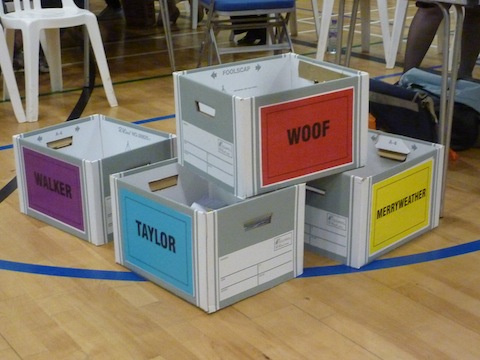 Abraham Lincoln
If given the truth, the people can be depended upon to meet any national crisis...
Abraham Lincoln
If given the truth, the people can be depended upon to meet any national crisis...
 Guildford news...
for Guildford people, brought to you by Guildford reporters - Guildford's own news service
Guildford news...
for Guildford people, brought to you by Guildford reporters - Guildford's own news service
Insights: Running an Election – Part Two The Count
Published on: 29 Apr, 2024
Updated on: 9 May, 2024
With more elections looming across the county, including one for the Police & Crime Commissioner role, Bernard Quoroll recounts his experiences as a local government officer and as a returning officer.
Part Two – The Count
former local authority CEO and returning officer
At 10 pm on election day polling staff anxiously fill in their end-of-day return, gather their election materials in sealed envelopes and bags and head off to deliver them at the count centre.
Things can still go wrong. A mishap with the car, piloted by a tired driver; a realisation that the sealed ballot paper return has not been filled in correctly and would need to be explained to the returning officer, or simply getting lost. Non-arrival would sometimes lead to a police car being sent out into the night.
Count centres are usually sports halls or similar large spaces where a stage and tables can be laid out and where security can be maintained. The senior team would be standing ready to receive and check the materials, one desk for the ballot paper returns, one for the unused ballots and counterfoils and a storage area for everything else.
Ballot boxes would be assigned a chalked place on the floor to allow a visual check on the arrival of boxes. Election materials had to remain accessible in case a ballot paper return is mathematically incorrect, or the number of ballots in the box does not match the return, so that the unused counterfoils need to be checked. The counters would sit in teams at tables hermetically sealed from election observers to ensure that opportunities for touching ballots were minimised.
This was planned and intended to be a theatrical event. The returning officer should aim to be the focal point.
As the count progresses I would patrol the floor, meeting and greeting candidates and mock-sternly rapping the hands of any observer sitting opposite the counters and seen trying to push ballot papers towards them. Touching ballots is strictly verboten!
At intervals, I would remind all present to keep the noise down so that counters could do their job. Have you ever tried to tell a politician to keep quiet?
Every so often I would call candidates and agents together to watch while I adjudicated doubtful ballots. The first thing to say is that the capacity of voters to fill in their ballots incorrectly never ceased to amaze me.
The theory is that you should adjudicate ballots so as to give effect to the clear intent of the voter. Confronted by ballots marked in the wrong place, even sometimes on the back, by endless permutations of hieroglyphs other than a simple X – so, cryptic messages, names, multiple crosses, ticks, zeros and “none of the above” – adjudicating was not always an easy task, especially when tired and surrounded by excited people.
There are several large tomes of examples deriving from case law which can and did provide bedtime reading for legally trained returning officers. Deciding whether a vote was good or bad for a particular candidate surrounded by the candidates themselves and their agents, all earnestly telling you why all those votes for themselves were good and all those for others, were bad, needed patience and humour.
The trick was to take the time to think logically through what was likely to have been in the voter’s mind on the evidence presented. Above all, there was a need to be consistent. Declaring one vote good and one bad on the same night in the same circumstances is a recipe for an election petition and an expensive rerun in a tight election.
 Election ballots, once counted in blocks of 25 or 50 and checked, would be stored in racks or troughs so that it would be possible visually to see how the tallies were building up. It was important to ensure that racks for every candidate were filled on a roughly equal basis, until that became unavoidable and a winner began to emerge.
Election ballots, once counted in blocks of 25 or 50 and checked, would be stored in racks or troughs so that it would be possible visually to see how the tallies were building up. It was important to ensure that racks for every candidate were filled on a roughly equal basis, until that became unavoidable and a winner began to emerge.
On one occasion where fortunately I was the deputy returning officer, I saw the sitting MP grab the lapels of my boss and physically drag him across the room to the troughs, because the stacking was not being built up evenly.
Sometimes you would see a candidate standing beside the mounting ballots with spouse and family, gradually realising that she or he was about to lose a coveted seat and become unemployed. No amount of friendly chat could disperse the coldness descending around them. It can be an emotional time for candidates. I have seen former councillors sitting crying on the Town Hall steps when they have unexpectedly lost.
Security has increasingly become an issue. Just before one count, I came across a man in a suit acting suspiciously so I asked him who he was. “Security,” he replied, so I asked to see his warrant card. He in revenge asked me who I was and I flashed a credit card which seemed to satisfy him.
But what do you do when, just as a count begins, the Earl of Shelburne, as he was then titled, strolls in, together with a posse of house guests, all wearing plus fours or jodhpurs and with no entry passes. He wants to round off their day’s entertainment by watching a count.
Fortunately there was plenty of space, as seats for observers are supposed to be issued proportionately to the number of candidates. As he was a very well known individual in the area I did not need to have proof of his identity and permitted him entry but in other circumstances would have had to turn him away, a decision which would not have been well received in that neck of the woods.
It is usually a forlorn hope to maintain silence during a count but toward the end, a sense of anticipation creates a kind of natural self-discipline. A discreet first cast of the votes is shared with candidates and agents and if the outcome is clear, the returning officer can breathe a sigh of relief.
Tomorrow part three – The Result
Recent Articles
- Ash Residents To Hear Plans For New Care Home On Land Set Aside For Health Purposes
- Police Seek Witnesses After Vintage Sign Is Stolen From Pub Garden
- ‘Help Us To Track Wildlife This Autumn’ – Surrey Charity’s Plea To Nature Lovers
- Letter: Are Vendor-linked Awards the Way to Go for Schools’ ICT?
- Letter: How Not to Engage the Public
- GBC Takes Legal Action Over Unauthorised Bramley Traveller Site
- Developers Release Early Plans For 950 Homes on Normandy Farmland
- Open Day at Silverbirch House Care Home and a Special Gift for One of its Residents
- Birdwatcher’s Diary No.336
- Behind The Picture Of Wealth and Prosperity – Surrey Has a Story of Inequality and Poverty



Search in Site
Media Gallery
Cllr Townsend on Waverley’s CIL Issue
August 27, 2025 / Comments Off on Cllr Townsend on Waverley’s CIL Issue / Read MoreMP Zöe Franklin Reviews Topical Issues
August 27, 2025 / Comments Off on MP Zöe Franklin Reviews Topical Issues / Read MoreMP Hopes Thames Water Fine Will Be ‘Final Nail in Its Coffin’
August 27, 2025 / Comments Off on MP Hopes Thames Water Fine Will Be ‘Final Nail in Its Coffin’ / Read MoreNew Guildford Mayor Howard Smith
August 27, 2025 / Comments Off on New Guildford Mayor Howard Smith / Read MoreA New Scene for a Guildford Street
August 27, 2025 / Comments Off on A New Scene for a Guildford Street / Read MoreDragon Interview: Sir Jeremy Hunt MP on His Knighthood and Some Local Issues
August 27, 2025 / Comments Off on Dragon Interview: Sir Jeremy Hunt MP on His Knighthood and Some Local Issues / Read MoreDragon Interview: Paul Follows Admits He Should Not Have Used the Word ‘Skewed’
August 27, 2025 / Comments Off on Dragon Interview: Paul Follows Admits He Should Not Have Used the Word ‘Skewed’ / Read MoreDragon Interview: Will Forster MP On His Recent Visit to Ukraine
August 27, 2025 / No Comment / Read MoreDragon Interview: Fiona Davidson on the ‘Devolution’ Proposals for Surrey
August 27, 2025 / No Comment / Read More














Recent Comments